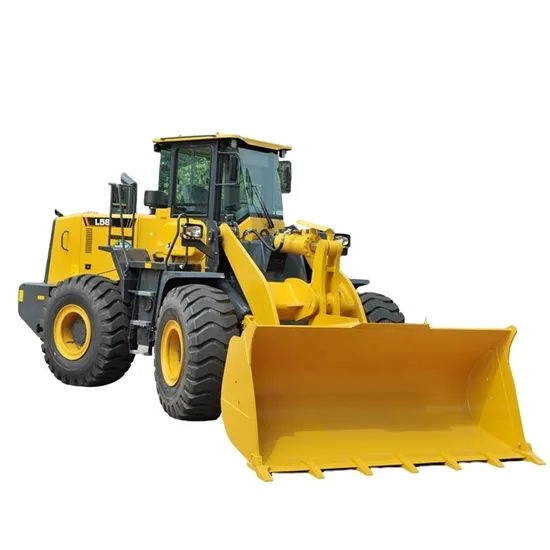When choosing a 5-ton loader, comprehensive consideration should be given to various factors such as specific operating scenarios, performance requirements, and usage costs. Here are the key selection points:

I. Clarify the Core Operating Scenarios
The 5-ton loader is a main model in the medium-tonnage category, with a wide range of applications. However, different scenarios have different emphases on performance:
- Mining/Heavy-load Operations: Attention should be paid to breakout force, traction, and durability. Priority should be given to models with reinforced booms, thickened buckets (such as those made of wear-resistant steel), and high-torque engines. For example, products equipped with high-power engines like Weichai WP10/WP12 can handle the loading of hard rocks and heavy materials.
- Port/Logistics Loading and Unloading: Emphasis is placed on operational efficiency and flexibility. Choose models with moderate bucket capacity (3-4m³), small turning radius, and smooth shifting. Some brands' "high-speed version" 5-ton machines (with a driving speed of ≥30km/h) can improve short-distance transfer efficiency.
- Infrastructure/Earthworks: Balance versatility and fuel consumption. Priority should be given to fuel-injected engines with low fuel consumption (such as Yuchai and Shangchai), paired with quickly replaceable attachments (such as log grapples and bulldozer blades) to adapt to various materials such as sand, earth, and construction waste.
- Municipal/Light Operations: If the operation involves urban areas, attention should be paid to noise and emission standards. Choose models that meet the National IV emission standards and are equipped with noise reduction devices. Some brands' 5-ton machines can be optionally equipped with enclosed cabs (with air conditioning and air filtration) to improve operational comfort.
II. Comparison of Core Performance Parameters
| Parameter | Key Indicators | Selection Suggestions |
|---|---|---|
| Engine | Power (≥120kW), torque reserve coefficient (≥25%), emission standards (National IV and above) | For heavy loads, choose high-power engines (such as above 160kW); for light loads/fuel saving, choose medium and small power engines (120-140kW); priority is given to well-known brands (Weichai, Cummins). |
| Breakout Force | Rated breakout force (≥160kN), unloading height (≥3.2m, matched according to truck height) | For mining/high unloading requirements, choose models with breakout force ≥180kN and unloading height ≥3.5m; for general scenarios, 160-180kN is sufficient. |
| Transmission | Type (hydro-mechanical transmission / planetary transmission), shifting mode (manual / automatic) | For heavy loads/complex road conditions, choose planetary transmission (with strong bearing capacity); for convenient operation, choose automatic transmission (to reduce driving fatigue). |
| Tires | Type (engineering tires / mining tires), size (mainly 23.5-25) | For mining/gravel roads, choose thickened mining tires (puncture-resistant); for ordinary dirt roads/asphalt roads, choose engineering tires (balancing wear resistance and cost). |
| Fuel Consumption | Fuel consumption per 100km (about 15-20L for heavy loads, about 10-15L for light loads) | For long-term high-frequency operations, priority is given to models with low fuel consumption (such as those with electronic fuel-saving systems) to reduce operating costs. |
III. Configuration Selection
Key configurations:
- Cab: Choose models with a wide field of vision, shock-absorbing seats, and heating and cooling air conditioning to improve comfort during long-time operations.
- Safety Configuration: Priority is given to models with reverse image, reverse radar, and overload protection, which are safer especially when operating in narrow spaces.
- Maintenance Convenience: Choose models where core components such as the engine and transmission are easy to overhaul (such as tilting cabs and centralized lubrication systems) to reduce maintenance time.
IV. Special Considerations for Electric 5-ton Loaders
In recent years, the penetration rate of electric 5-ton loaders has increased rapidly (accounting for 62.78% of electric loader sales in July 2025). If the operating scenario meets the following conditions, priority can be given to them:
- Fixed operating sites (such as mixing stations, ports) and regular operating hours (facilitating charging);
- High requirements for noise and environmental protection (such as municipal engineering, indoor operations);
- Long-term use (electricity costs are much lower than fuel costs, and the price difference can be recovered in 3-5 years).
When choosing, attention should be paid to battery capacity (battery life ≥6-8 hours), charging efficiency (supporting fast charging), and motor power (matching heavy-load requirements).
V. Summary Suggestions
- Heavy-load/Harsh Working Conditions: Choose fuel-powered models with high-power engines and reinforced structures;
- General/Medium-High Frequency Operations: Balance fuel consumption and efficiency, and select mainstream models with rich configurations;
- Environmental Protection/Fixed Scenarios: Give priority to electric 5-ton loaders, which have better long-term economy.





